CHEVROLET CORVETTE 2008 6.G Manual PDF
Manufacturer: CHEVROLET, Model Year: 2008, Model line: CORVETTE, Model: CHEVROLET CORVETTE 2008 6.GPages: 432, PDF Size: 2.4 MB
Page 71 of 432
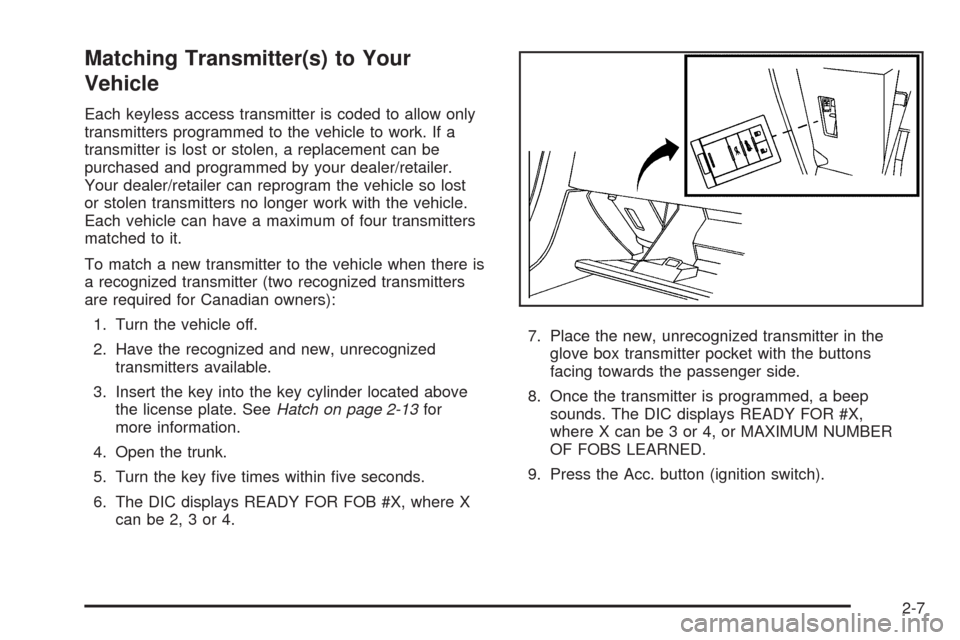
Matching Transmitter(s) to Your
Vehicle
Each keyless access transmitter is coded to allow only
transmitters programmed to the vehicle to work. If a
transmitter is lost or stolen, a replacement can be
purchased and programmed by your dealer/retailer.
Your dealer/retailer can reprogram the vehicle so lost
or stolen transmitters no longer work with the vehicle.
Each vehicle can have a maximum of four transmitters
matched to it.
To match a new transmitter to the vehicle when there is
a recognized transmitter (two recognized transmitters
are required for Canadian owners):
1. Turn the vehicle off.
2. Have the recognized and new, unrecognized
transmitters available.
3. Insert the key into the key cylinder located above
the license plate. SeeHatch on page 2-13for
more information.
4. Open the trunk.
5. Turn the key �ve times within �ve seconds.
6. The DIC displays READY FOR FOB #X, where X
can be 2, 3 or 4.7. Place the new, unrecognized transmitter in the
glove box transmitter pocket with the buttons
facing towards the passenger side.
8. Once the transmitter is programmed, a beep
sounds. The DIC displays READY FOR #X,
where X can be 3 or 4, or MAXIMUM NUMBER
OF FOBS LEARNED.
9. Press the Acc. button (ignition switch).
2-7
Page 72 of 432
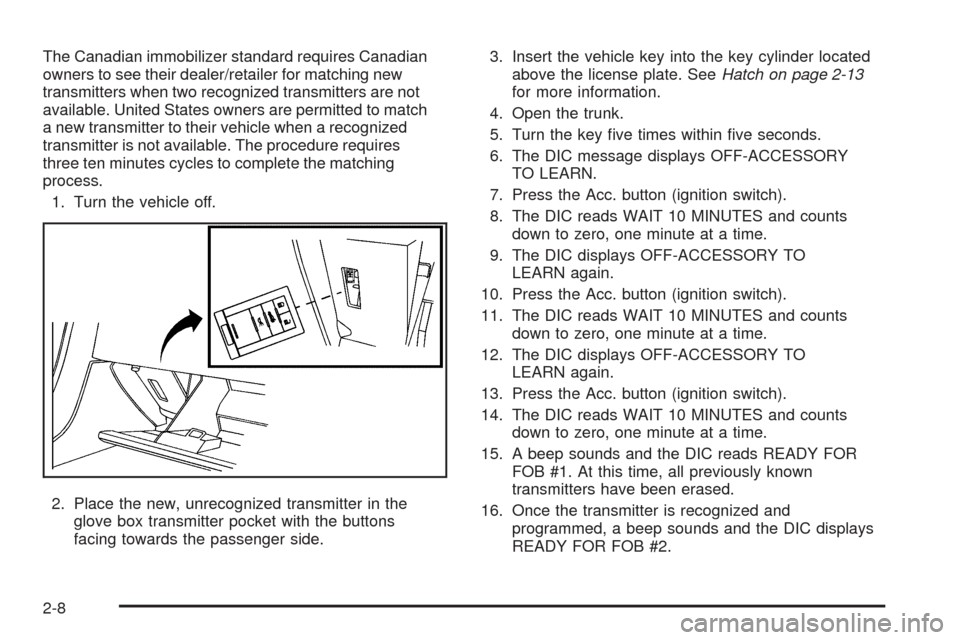
The Canadian immobilizer standard requires Canadian
owners to see their dealer/retailer for matching new
transmitters when two recognized transmitters are not
available. United States owners are permitted to match
a new transmitter to their vehicle when a recognized
transmitter is not available. The procedure requires
three ten minutes cycles to complete the matching
process.
1. Turn the vehicle off.
2. Place the new, unrecognized transmitter in the
glove box transmitter pocket with the buttons
facing towards the passenger side.3. Insert the vehicle key into the key cylinder located
above the license plate. SeeHatch on page 2-13
for more information.
4. Open the trunk.
5. Turn the key �ve times within �ve seconds.
6. The DIC message displays OFF-ACCESSORY
TO LEARN.
7. Press the Acc. button (ignition switch).
8. The DIC reads WAIT 10 MINUTES and counts
down to zero, one minute at a time.
9. The DIC displays OFF-ACCESSORY TO
LEARN again.
10. Press the Acc. button (ignition switch).
11. The DIC reads WAIT 10 MINUTES and counts
down to zero, one minute at a time.
12. The DIC displays OFF-ACCESSORY TO
LEARN again.
13. Press the Acc. button (ignition switch).
14. The DIC reads WAIT 10 MINUTES and counts
down to zero, one minute at a time.
15. A beep sounds and the DIC reads READY FOR
FOB #1. At this time, all previously known
transmitters have been erased.
16. Once the transmitter is recognized and
programmed, a beep sounds and the DIC displays
READY FOR FOB #2.
2-8
Page 73 of 432
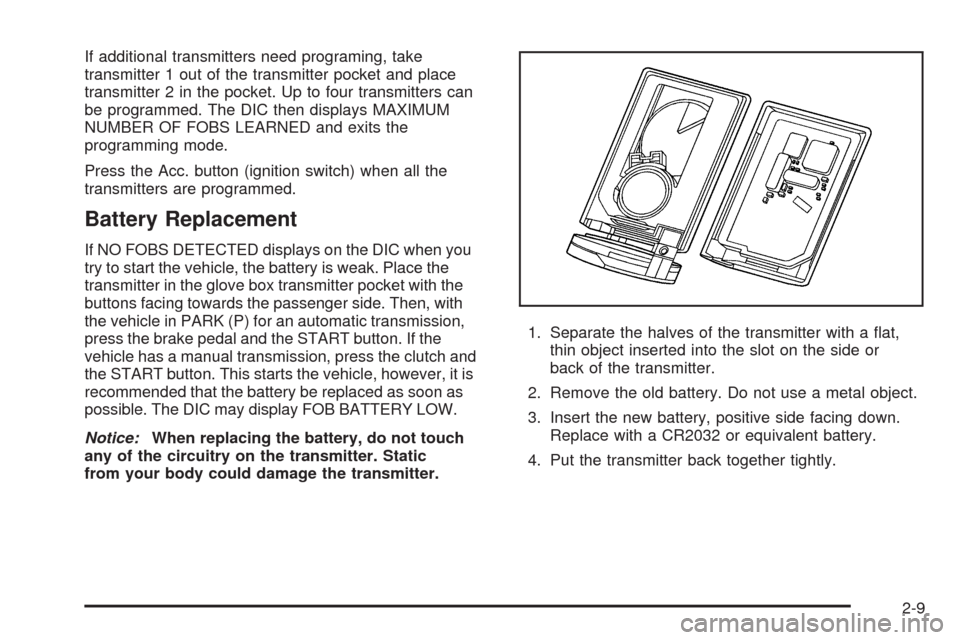
If additional transmitters need programing, take
transmitter 1 out of the transmitter pocket and place
transmitter 2 in the pocket. Up to four transmitters can
be programmed. The DIC then displays MAXIMUM
NUMBER OF FOBS LEARNED and exits the
programming mode.
Press the Acc. button (ignition switch) when all the
transmitters are programmed.
Battery Replacement
If NO FOBS DETECTED displays on the DIC when you
try to start the vehicle, the battery is weak. Place the
transmitter in the glove box transmitter pocket with the
buttons facing towards the passenger side. Then, with
the vehicle in PARK (P) for an automatic transmission,
press the brake pedal and the START button. If the
vehicle has a manual transmission, press the clutch and
the START button. This starts the vehicle, however, it is
recommended that the battery be replaced as soon as
possible. The DIC may display FOB BATTERY LOW.
Notice:When replacing the battery, do not touch
any of the circuitry on the transmitter. Static
from your body could damage the transmitter.1. Separate the halves of the transmitter with a �at,
thin object inserted into the slot on the side or
back of the transmitter.
2. Remove the old battery. Do not use a metal object.
3. Insert the new battery, positive side facing down.
Replace with a CR2032 or equivalent battery.
4. Put the transmitter back together tightly.
2-9
Page 74 of 432
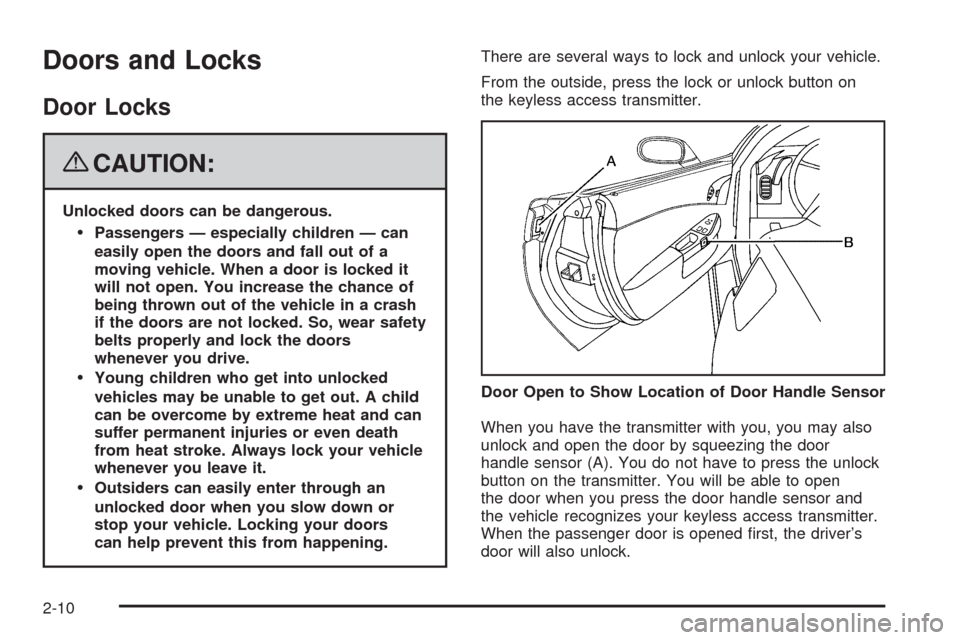
Doors and Locks
Door Locks
{CAUTION:
Unlocked doors can be dangerous.
Passengers — especially children — can
easily open the doors and fall out of a
moving vehicle. When a door is locked it
will not open. You increase the chance of
being thrown out of the vehicle in a crash
if the doors are not locked. So, wear safety
belts properly and lock the doors
whenever you drive.
Young children who get into unlocked
vehicles may be unable to get out. A child
can be overcome by extreme heat and can
suffer permanent injuries or even death
from heat stroke. Always lock your vehicle
whenever you leave it.
Outsiders can easily enter through an
unlocked door when you slow down or
stop your vehicle. Locking your doors
can help prevent this from happening.There are several ways to lock and unlock your vehicle.
From the outside, press the lock or unlock button on
the keyless access transmitter.
When you have the transmitter with you, you may also
unlock and open the door by squeezing the door
handle sensor (A). You do not have to press the unlock
button on the transmitter. You will be able to open
the door when you press the door handle sensor and
the vehicle recognizes your keyless access transmitter.
When the passenger door is opened �rst, the driver’s
door will also unlock.Door Open to Show Location of Door Handle Sensor
2-10
Page 75 of 432
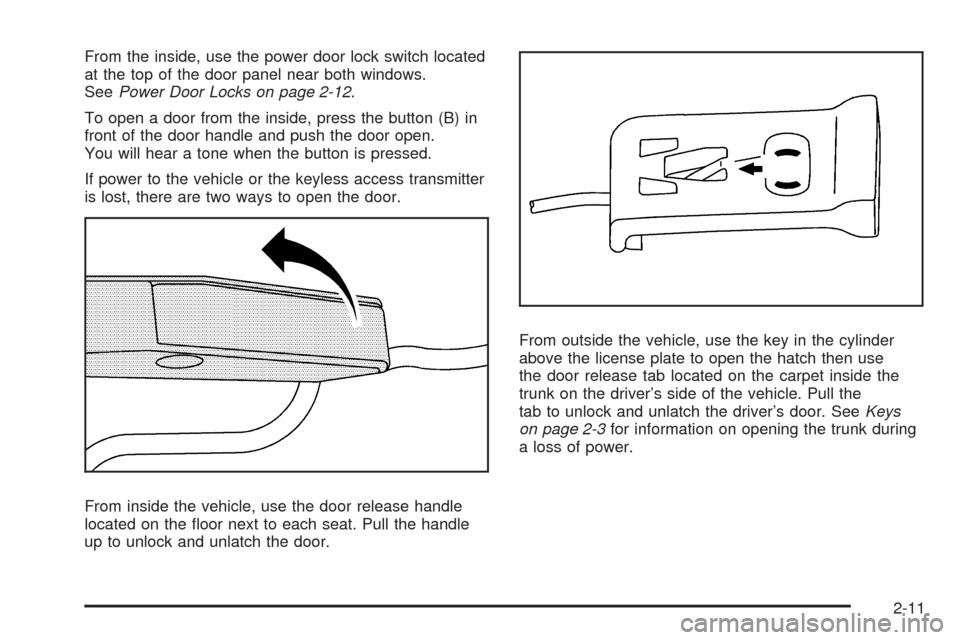
From the inside, use the power door lock switch located
at the top of the door panel near both windows.
SeePower Door Locks on page 2-12.
To open a door from the inside, press the button (B) in
front of the door handle and push the door open.
You will hear a tone when the button is pressed.
If power to the vehicle or the keyless access transmitter
is lost, there are two ways to open the door.
From inside the vehicle, use the door release handle
located on the �oor next to each seat. Pull the handle
up to unlock and unlatch the door.From outside the vehicle, use the key in the cylinder
above the license plate to open the hatch then use
the door release tab located on the carpet inside the
trunk on the driver’s side of the vehicle. Pull the
tab to unlock and unlatch the driver’s door. SeeKeys
on page 2-3for information on opening the trunk during
a loss of power.
2-11
Page 76 of 432
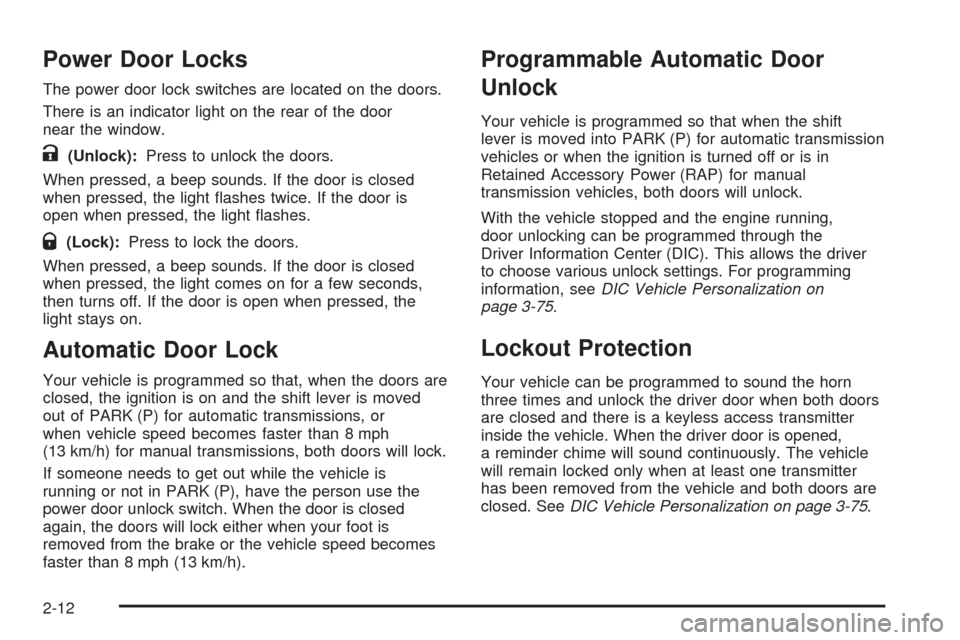
Power Door Locks
The power door lock switches are located on the doors.
There is an indicator light on the rear of the door
near the window.
K(Unlock):Press to unlock the doors.
When pressed, a beep sounds. If the door is closed
when pressed, the light �ashes twice. If the door is
open when pressed, the light �ashes.
Q(Lock):Press to lock the doors.
When pressed, a beep sounds. If the door is closed
when pressed, the light comes on for a few seconds,
then turns off. If the door is open when pressed, the
light stays on.
Automatic Door Lock
Your vehicle is programmed so that, when the doors are
closed, the ignition is on and the shift lever is moved
out of PARK (P) for automatic transmissions, or
when vehicle speed becomes faster than 8 mph
(13 km/h) for manual transmissions, both doors will lock.
If someone needs to get out while the vehicle is
running or not in PARK (P), have the person use the
power door unlock switch. When the door is closed
again, the doors will lock either when your foot is
removed from the brake or the vehicle speed becomes
faster than 8 mph (13 km/h).
Programmable Automatic Door
Unlock
Your vehicle is programmed so that when the shift
lever is moved into PARK (P) for automatic transmission
vehicles or when the ignition is turned off or is in
Retained Accessory Power (RAP) for manual
transmission vehicles, both doors will unlock.
With the vehicle stopped and the engine running,
door unlocking can be programmed through the
Driver Information Center (DIC). This allows the driver
to choose various unlock settings. For programming
information, seeDIC Vehicle Personalization on
page 3-75.
Lockout Protection
Your vehicle can be programmed to sound the horn
three times and unlock the driver door when both doors
are closed and there is a keyless access transmitter
inside the vehicle. When the driver door is opened,
a reminder chime will sound continuously. The vehicle
will remain locked only when at least one transmitter
has been removed from the vehicle and both doors are
closed. SeeDIC Vehicle Personalization on page 3-75.
2-12
Page 77 of 432
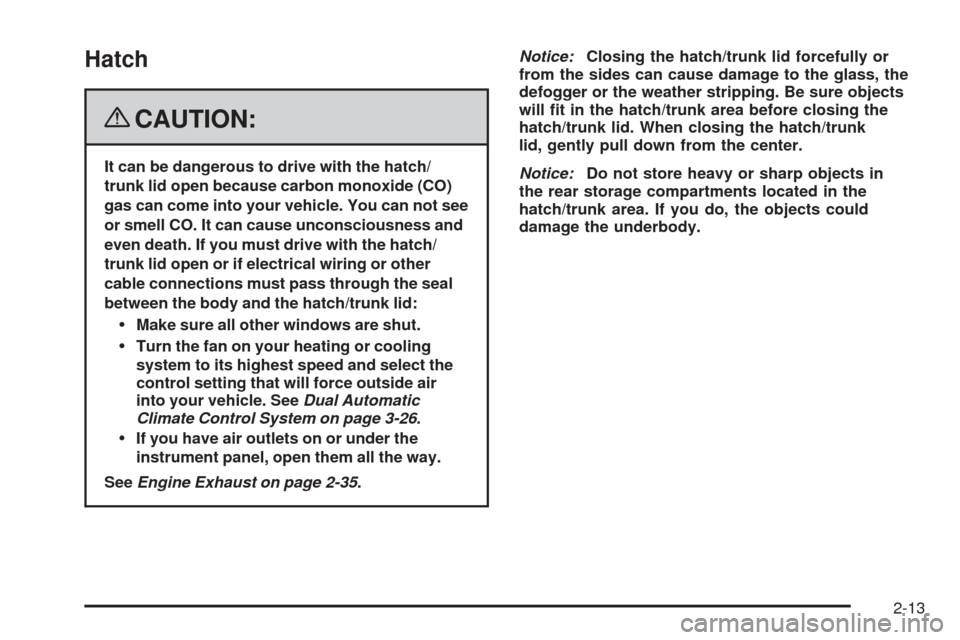
Hatch
{CAUTION:
It can be dangerous to drive with the hatch/
trunk lid open because carbon monoxide (CO)
gas can come into your vehicle. You can not see
or smell CO. It can cause unconsciousness and
even death. If you must drive with the hatch/
trunk lid open or if electrical wiring or other
cable connections must pass through the seal
between the body and the hatch/trunk lid:
Make sure all other windows are shut.
Turn the fan on your heating or cooling
system to its highest speed and select the
control setting that will force outside air
into your vehicle. SeeDual Automatic
Climate Control System on page 3-26.
If you have air outlets on or under the
instrument panel, open them all the way.
SeeEngine Exhaust on page 2-35.Notice:Closing the hatch/trunk lid forcefully or
from the sides can cause damage to the glass, the
defogger or the weather stripping. Be sure objects
will �t in the hatch/trunk area before closing the
hatch/trunk lid. When closing the hatch/trunk
lid, gently pull down from the center.
Notice:Do not store heavy or sharp objects in
the rear storage compartments located in the
hatch/trunk area. If you do, the objects could
damage the underbody.
2-13
Page 78 of 432
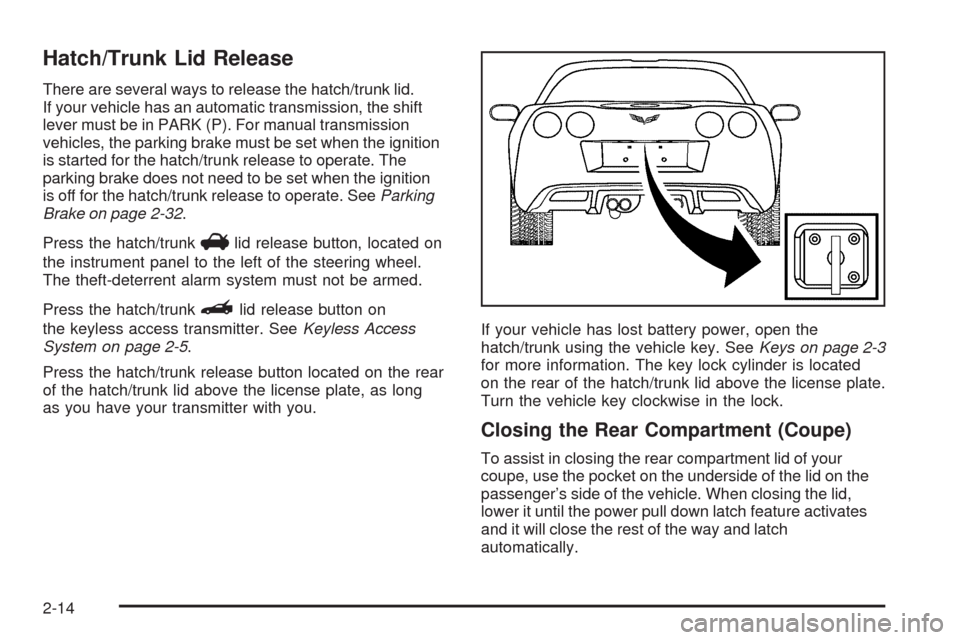
Hatch/Trunk Lid Release
There are several ways to release the hatch/trunk lid.
If your vehicle has an automatic transmission, the shift
lever must be in PARK (P). For manual transmission
vehicles, the parking brake must be set when the ignition
is started for the hatch/trunk release to operate. The
parking brake does not need to be set when the ignition
is off for the hatch/trunk release to operate. SeeParking
Brake on page 2-32.
Press the hatch/trunk
Vlid release button, located on
the instrument panel to the left of the steering wheel.
The theft-deterrent alarm system must not be armed.
Press the hatch/trunk
}lid release button on
the keyless access transmitter. SeeKeyless Access
System on page 2-5.
Press the hatch/trunk release button located on the rear
of the hatch/trunk lid above the license plate, as long
as you have your transmitter with you.If your vehicle has lost battery power, open the
hatch/trunk using the vehicle key. SeeKeys on page 2-3
for more information. The key lock cylinder is located
on the rear of the hatch/trunk lid above the license plate.
Turn the vehicle key clockwise in the lock.
Closing the Rear Compartment (Coupe)
To assist in closing the rear compartment lid of your
coupe, use the pocket on the underside of the lid on the
passenger’s side of the vehicle. When closing the lid,
lower it until the power pull down latch feature activates
and it will close the rest of the way and latch
automatically.
2-14
Page 79 of 432
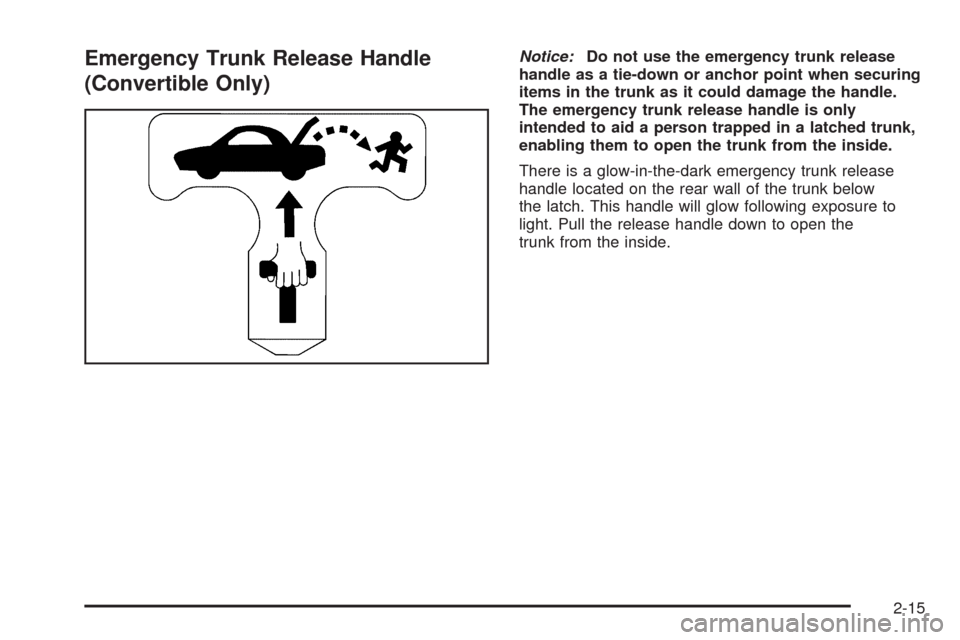
Emergency Trunk Release Handle
(Convertible Only)Notice:Do not use the emergency trunk release
handle as a tie-down or anchor point when securing
items in the trunk as it could damage the handle.
The emergency trunk release handle is only
intended to aid a person trapped in a latched trunk,
enabling them to open the trunk from the inside.
There is a glow-in-the-dark emergency trunk release
handle located on the rear wall of the trunk below
the latch. This handle will glow following exposure to
light. Pull the release handle down to open the
trunk from the inside.
2-15
Page 80 of 432
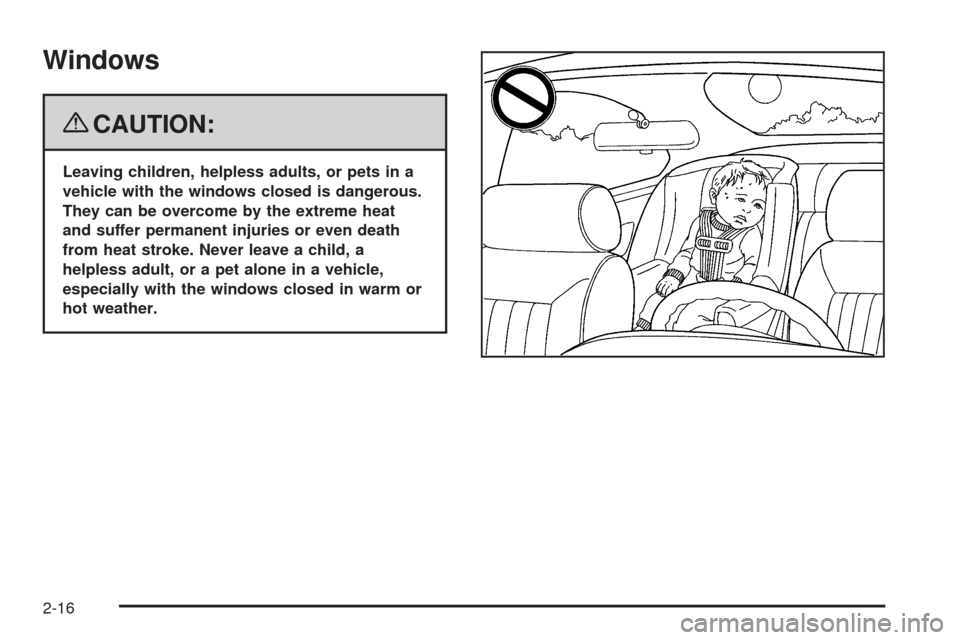
Windows
{CAUTION:
Leaving children, helpless adults, or pets in a
vehicle with the windows closed is dangerous.
They can be overcome by the extreme heat
and suffer permanent injuries or even death
from heat stroke. Never leave a child, a
helpless adult, or a pet alone in a vehicle,
especially with the windows closed in warm or
hot weather.
2-16